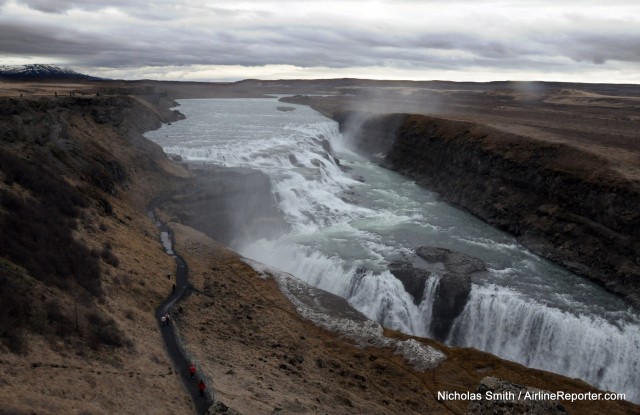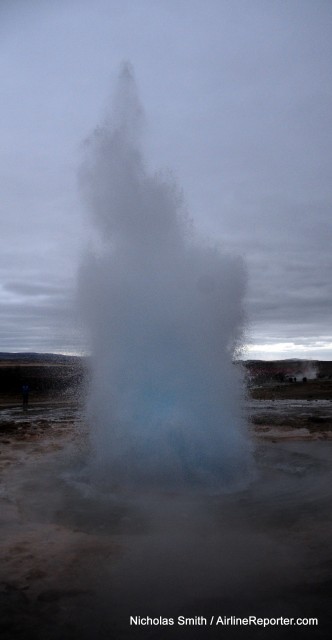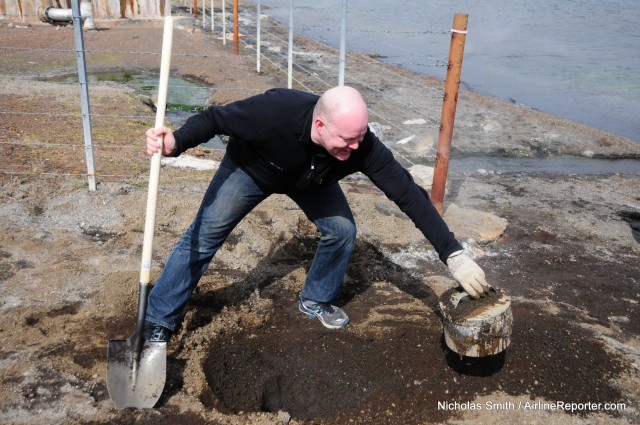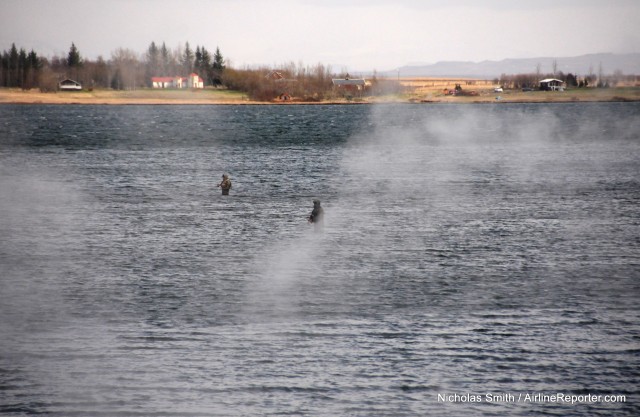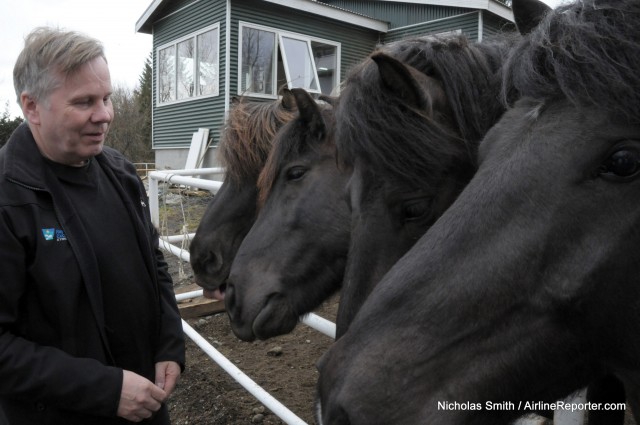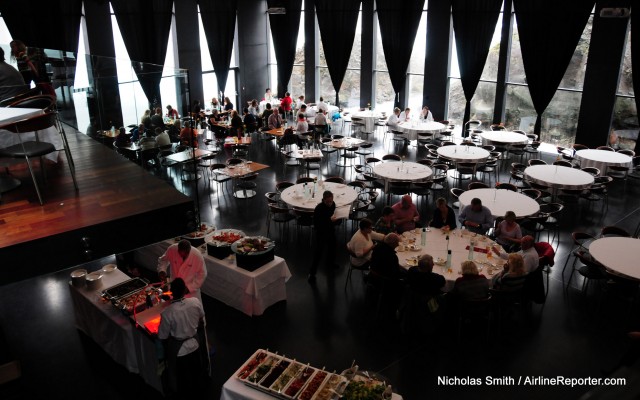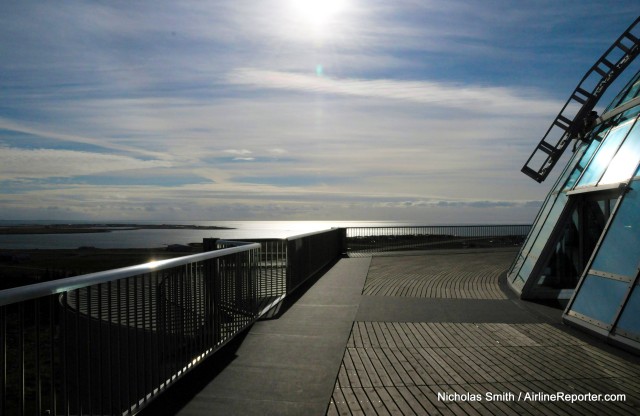
The summer’s ever-persistent sun over the Perlan (the Perl), a hot water storage facility turned museum and mall
This is a continued story about AirlineReporter.com visiting Iceland, via Icelandair. Be sure you first check out: Review: Traveling from Seattle to Keflavàk on an Icelandair Boeing 757 & Why Iceland is Not Just a Stopover, But a Destination ’“ PART 1.
We spent the next day touring the Golden Circle, which took us about 185mi up into central Iceland and back. The first stop was Gullfoss (the Golden Fall). Walking down the path through misty spray reveals the breathtaking two-stage falls. Unlike falls in the US, there’s nothing but a little rope keeping onlookers from wandering too close to the edge. It felt a little dangerous and I liked it!
We also toured the Haukadalur geothermal area, north of the Laugarvatn. Here lies the original Geyser (Geysir; yes, it’s an Icelandic name from the word geysa, meaning ’œto gush’).
These days, Geysir only erupts a few times a day. Nearby, however, Strokkur erupts warm sulfur-smelling water over a hundred feet into the air, every five minutes or so. I watched three eruptions and could have stayed longer; the warm shower that came down was present as the sun had just ducked behind the clouds. But be cautious — you could end up having your camera destroyed.
Next we were off to the Laugarvatn Fontana Geothermal Baths. The edge of the lake Laughrvatn eerily steamed as we approached. First thing once we arrived, the steward of the baths invited us out to the lake’s edge where he dug up a buried case of rye bread from the steaming shore. Yes… rye bread.
The ground all around our feet bubbled with steamy warmth, but this wasn’t just dirt, but a sort of oven. A local baker uses the geothermal heat nearby to make rye bread, ready each day at around 2pm. I enjoyed some with a cut of smoked trout caught from the same lake and butter from a nearby farm. Once my stomach was full, it was time to try out the baths.
Since the bath and steam houses are fed directly from the geothermal springs beneath, they vary in temperature from day to day. Three steam rooms and multiple baths allow you to find the perfect temperature. Too warm? Prop open a door. Too cold? Move to the next room’¦
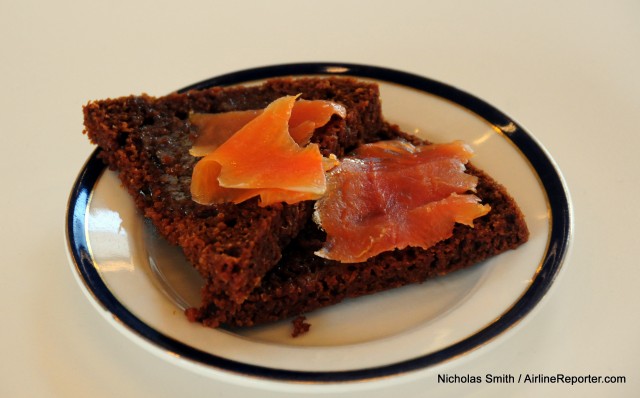
Fontana’s geothermally baked, all-natural rye bread with delicate smoked trout from Lake Laugarvatn, and locally produced butter
I pruned up nicely and cleared my skin, lungs and mind while looking out over the lake. Apparently it’s quite pleasant here in the winter; the springs allow year-round enjoyment of the outdoors.
BONUS: Guest Review: Flying Icelandair from Seattle to France
Depending on the winds and the way the spring water mixes in the lake, it can be anywhere from tolerable to downright pleasant for swimming. I took their word for it and decided not to go for a quick swim.
The site of Fontana was originally a shack built by construction workers building a nearby girl’s school in 1928. They discovered and used the steam to relax after a hard day’s work and thankfully the secret wasn’t lost.
I have to say that geothermal heat is quite amazing; every building I visited in Iceland was very warm. Being based in Seattle, I am not used to the heat, so I found myself opening a window or stepping outside to cool off frequently.
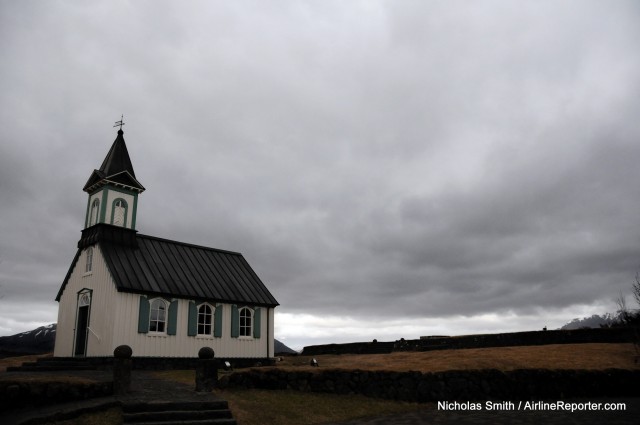
Skálholt Cathedral, near the location of the Parliament established in 930ce, and the location of Iceland’s Episcopal see from 1056 until 1785. This location is still active and located near lodges.
Next, we visited the àžingvellir National Park, along which is the divide between the North American and European continents. Iceland is in both Europe and America, the divide running through this park. This is also the location of Iceland’s first Parliament, which operated here from 930 to 1798. The history here is positively stunning (over a thousand years of continuing operation, up to almost modern times).
Rare is the opportunity to jump from one tectonic plate to another. I took that opportunity to stroll from side to side of this fault line, visiting America, visiting Europe, going back to America, and so on (yes, I was an obnoxious tourist, but it was fabulous!)
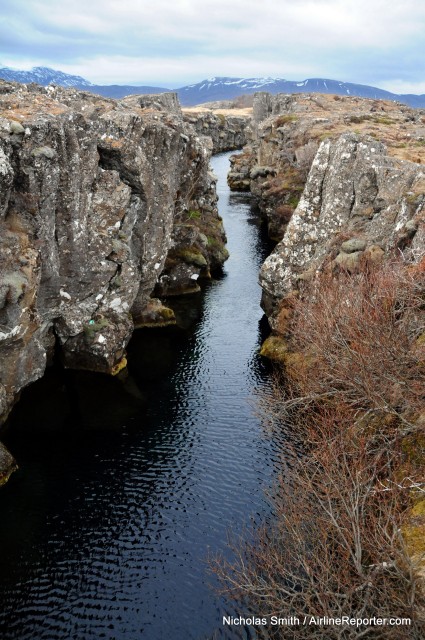
As with everywhere else in Iceland, àžingvellir Park offers serenely-pure breezes and streams that seem cleansing.
Farming in Iceland is a tricky endeavor. The climate isn’t compatible with fruit production and Iceland has very little farm soil. The soil it does have is rich, entirely composed of mossy deposits that have built up and decomposed over volcanic rock for thousands of years. This doesn’t stop folks from devising ingenious methods to grow fruit; we visited Frià°heimar, a farm that hydroponically grows four varieties of tomatoes and breeds the trademark Icelandic horse.
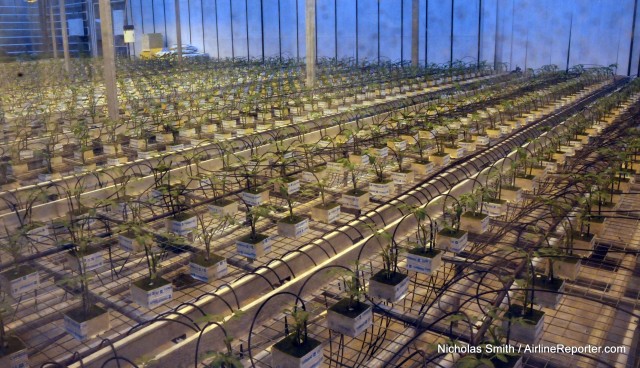
Tomato starters that will soon fulfill about 18% of Iceland’s tomato consumption. Plants produce constantly so they must rotate every six months.
Frià°heimar produces about 300 tons of tomatoes, harvesting every day of the year, and maintaining precise control of CO2, temperature, humidity, light, irrigation, bumble bee population, volcanic pumice quality, nutrients, and leaf count (yes, there’s an optimal number of leafs each tomato variety should have per plant for optimal fruit production; they’ve figured out everything).
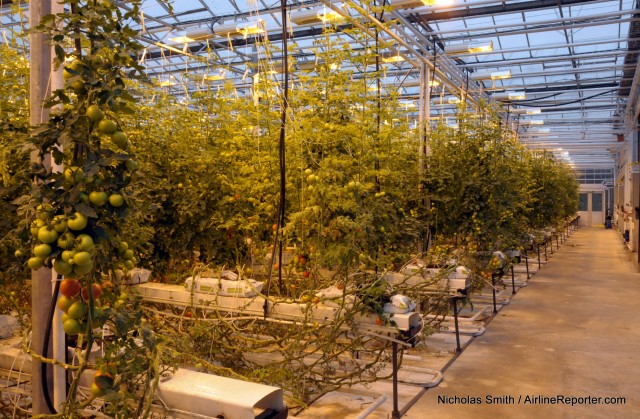
Rows of tomatoes in Frià°heimar’s advanced greenhouses, using geothermal heat, geothermally-generated electric light, captured geothermal CO2, and scientifically-optimized growing techniques.
Iceland has been fueling greenhouses with geothermal energy since 1923, every year improving upon their processes. Similar greenhouses produce year-round grapes, tomatoes, strawberries, cucumbers, lettuce, peppers, herbs, and more. The tomato aroma within this glass building thickened my appetite, so I took the opportunity to chow down on their tomato soup and fresh bread — delicious.
Our guide mentioned that Frià°heimar breeds top quality horses so we stepped outside to take a look. Icelandic horses were brought to the continent in 9th century by Scandinavians and haven’t mixed with other breeds since the 900s. Because of this, the Iceland breed is ancient and unchanged.
The country outlawed importation of horses in 983AD to prevent contamination of bloodlines and disease. Once a horse leaves the island, it may never return. These horses developed into a stout, short, and well-insulated breed through natural and human selection. The horses in the yard welcomed a scratch from our guide.
Horse rides are available around the island; it’s a treat to meet a horse breed that’s over a thousand years old!
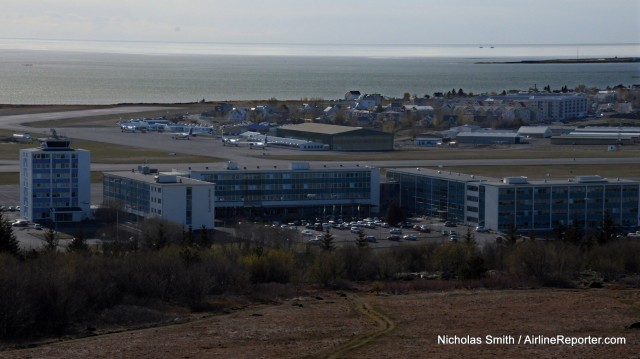
The Reykjavàk Natura hotel looks as it did the day it was completed, and houses the Soley Natura Spa, Satt Restaurant, serves as the Reykjavàk Airport, and holds the headquarters of Icelandair.
That evening we dined at Satt Restaurant, which is located within the historic Reykjavàk Natura. The look is deceiving as its exterior is preserved as a 1960s historical building. The interior, however, is newly-renovated, stylish, and comfortable. Satt serves top-quality meals entirely from fresh locally-grown ingredients (as is apparently the practice around these parts). Again re-energized from the light, natural dinner that burst with flavor, I set out to observe the night life.
Icelandair brought together several hotels around the island, some operating all year and some in the north that can only operate during the summer. This year, they each adopted a theme that integrates a local cultural story into the stay for the international traveler.
I can personally vouch for the Natura and Marina as places I’ll certainly bring my friends. Touring the Marina’s rooms made me want to stay, and I rented a room in the Natura last year, which served as a meditative experience.
Numbering eight in total, Icelandair Hotels include the new Akureyri in the far north (near skiing), the Harad in Egilsstadir, the Klaustur nestled between two glaciers, the Fludir in south Iceland, the Hamar on a secluded golf course where one can watch the northern lights out of the hotel window, and Keflavik right near the airport.
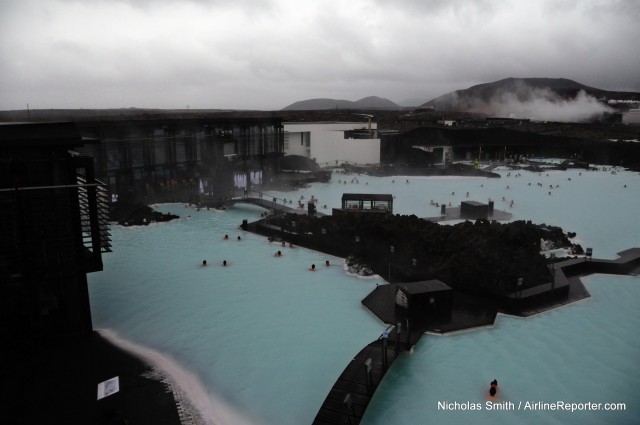
The Blue Lagoon’s geothermal baths are the perfect way to loosen the muscles and unwind before a flight or during a layover.
Once back at the Hilton, I freshened up and headed out downtown. The center of nightlife is a 17-minute walk from the hotel, and taxis are plentiful. Starting off at about 10pm, the night was in full swing. I haven’t seen that sort of inclusive partying since college.
Grandmothers were out drinking with their granddaughters, parents with their kids, groups of college grads, etc. It really was incredible. It reminded me of a family get together where everyone at least vaguely knew everyone else (they probably did). Live music and dance halls overflowed into the streets until the late (or early) morning.
After a nap and frenzied packing session, we loaded up and headed to the airport. On the way, we took the opportunity hit up the Blue Lagoon for a soak and lunch before departure. Soaking in the mineral water primes the body for a long nap on your way to your destination.
On the short ride to the airport (KEF), I realized that I’d not taken advantage of the volcanic tours (where you can actually spelunk into a colorful volcanic cavern), the helicopter tours, the glacier hikes, the off-road trail exploration packages, fishing trips, golf outings, northern lights watching, museums, concerts, horseback riding, skiing, etc. Needless to say there is quite a bit to do in Iceland.
I have now been twice to Iceland and I’m already planning my next trip.
NOTE: Icelandair paid for my flight and trip to Iceland. All opinions are my own.
